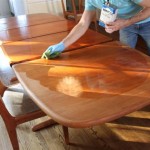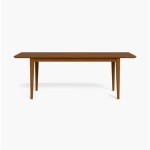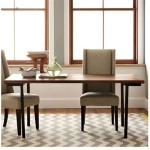The Enduring Appeal of the Round Pedestal Dining Table: A Focus on White Designs
The round pedestal dining table, particularly in its white iteration, represents a confluence of aesthetic appeal and functional design. This furniture piece has consistently maintained popularity across diverse interior styles, from classic to contemporary. The absence of obstructive legs facilitates comfortable seating arrangements, encouraging conversation and creating a more inclusive dining experience. White, as a color choice, introduces a sense of lightness and versatility, allowing the table to seamlessly integrate into various room décors.
Understanding the nuances of round pedestal dining tables in white requires an examination of materials, stylistic variations, size considerations, and maintenance requirements. Each of these elements contributes to the overall suitability of the table for a specific living space and lifestyle.
Material Composition and Its Impact
The longevity and visual character of a round pedestal dining table are intrinsically linked to the materials used in its construction. Several common materials are employed, each possessing distinct advantages and disadvantages. Understanding these differences is crucial for making an informed purchase.
Solid wood, particularly hardwoods like maple, oak, and birch, offers exceptional durability and a natural aesthetic. A white finish on solid wood typically involves painting or lacquering. Painted finishes can be susceptible to chipping and scratching, requiring periodic touch-ups. Lacquered finishes, while more durable, often impart a glossy sheen. Solid wood tables are generally more expensive but offer a significant lifespan and potential for refinishing.
Wood veneers, consisting of a thin layer of hardwood applied over a core of engineered wood (such as MDF or plywood), provide a cost-effective alternative to solid wood. Veneer tables can mimic the appearance of solid wood at a fraction of the price. The quality of the veneer and the core material is critical. MDF offers a smooth, stable surface ideal for painting, resulting in a clean, even white finish. However, veneer tables are less resistant to damage and cannot be easily refinished.
Manufactured wood products, such as MDF (Medium-Density Fiberboard) and particleboard, are widely used in the construction of dining tables, especially for pedestal bases. These materials are inexpensive and readily available, making them a popular choice for budget-conscious consumers. MDF, in particular, provides a smooth surface that is well-suited for painting, resulting in a consistent white finish. However, MDF and particleboard are less durable than solid wood or plywood and are more susceptible to water damage and swelling. Tables constructed primarily from manufactured wood products typically have a shorter lifespan.
Metal, often used in the pedestal base, adds structural integrity and can contribute to a modern or industrial aesthetic. When painted white, metal creates a clean and contemporary look. Powder-coated metal finishes are exceptionally durable and resistant to scratches and corrosion. Stainless steel, while not typically painted, can be used for accents or as a base with a clear coat to protect the surface.
Acrylic and resin are increasingly utilized in modern dining table designs. These materials can be molded into various shapes and finished in glossy white, offering a sleek and minimalist aesthetic. Acrylic and resin tables are lightweight and easy to clean, but they may be more susceptible to scratches and discoloration than other materials.
Stylistic Variations: From Traditional to Modern
The round pedestal dining table in white manifests in a wide range of styles, catering to diverse design preferences. The specific styling of the table is determined by the shape of the pedestal base, the tabletop edge detail, and the overall proportions of the piece.
Traditional designs often feature ornate pedestal bases with intricate carvings or fluted details. These tables typically have a substantial presence and are often paired with formal dining chairs. The white finish in traditional styles may be distressed or antiqued to create a sense of age and character. Tabletop edges may be rounded or feature decorative moldings.
Transitional styles bridge the gap between traditional and contemporary design. These tables often incorporate elements of both styles, such as a simplified pedestal base with subtle curves or a clean, unadorned tabletop. The white finish is typically a brighter, more modern shade, and the overall aesthetic is less formal than traditional designs.
Modern and contemporary styles emphasize clean lines, minimalist forms, and geometric shapes. These tables often feature a simple cylindrical or conical pedestal base and a round tabletop with a straight or slightly beveled edge. The white finish is typically a high-gloss or matte lacquer, creating a sleek and sophisticated look. Some modern designs incorporate glass or metal accents.
Rustic and farmhouse styles embrace a more relaxed and informal aesthetic. These tables often feature a distressed or weathered white finish, exposing the natural wood grain beneath. The pedestal base may be crafted from reclaimed wood or feature simple, unadorned designs. The tabletop may have a slightly uneven surface or a live edge to enhance the rustic character.
Scandinavian designs prioritize functionality, simplicity, and natural materials. White-painted wood is a hallmark of Scandinavian style. Round pedestal dining tables in this style often feature a simple, tapered pedestal base and a round tabletop with a clean, uncluttered design. The white finish is typically a soft, matte white, creating a warm and inviting atmosphere.
Size, Shape, and Spatial Considerations
Selecting the appropriate size and shape of a round pedestal dining table is crucial for ensuring both functionality and aesthetic harmony within a dining space. Careful consideration must be given to the dimensions of the room, the number of people who will typically be seated at the table, and the desired flow of traffic.
Round tables are particularly well-suited for smaller spaces, as they require less floor space than rectangular tables. The absence of corners also makes them safer for children and easier to navigate around. However, round tables may not be ideal for larger gatherings, as they can make it difficult for guests to interact with each other across the table.
The diameter of the round tabletop should be carefully considered based on the number of people who will typically be seated at the table. A general guideline is to allow at least 24 inches of space per person. A 48-inch diameter table can comfortably seat four people, while a 60-inch diameter table can accommodate six. Larger round tables are available, but they may require a larger dining space.
The height of the pedestal base is also important. Standard dining table height is typically between 28 and 30 inches. The chairs should be selected to ensure comfortable legroom and proper posture. The height of the chair seat should be approximately 12 inches below the tabletop.
The shape of the pedestal base can also impact the overall stability and visual appeal of the table. A wide, stable base is essential to prevent the table from tipping over, especially when it is fully loaded with dishes and beverages. The design of the base should also complement the overall style of the table and the surrounding décor.
In addition to the table's dimensions, consider the surrounding space. Leave ample room around the table for chairs to be pulled out and for people to move freely. A minimum of 36 inches is recommended between the edge of the table and any walls or other furniture. This ensures a comfortable and functional dining area.
Expandable or extendable round pedestal dining tables offer a flexible solution for those who occasionally need to accommodate larger groups. These tables typically feature a leaf or leaves that can be inserted into the center of the tabletop to increase its diameter. When not in use, the leaves can be stored separately, allowing the table to revert to its smaller, more space-efficient size.
The choice of materials, stylistic elements, and size considerations are crucial factors in determining the suitability of a white round pedestal dining table for a particular space. A careful evaluation of these factors will ensure a purchase that is both aesthetically pleasing and functionally sound.

Avenida Round Pedestal Dining Table 54 Pottery Barn

Maru Round Oak Pedestal Dining Table Washed White Daals

Fairview 42 Wide Pure White Round Wood Pedestal Dining Table 87r75 Lamps Plus

Beaufort 5 Piece White With Nutmeg Top Round Oval Pedestal Dining Tabl

White Pedestal Dining Tables Furniture Choice

46 White Round Pedestal Dining Table

Vintage Retro Round Pedestal Dining Table Diner

Modern Round Pedestal Dining Table For 6 With White Sintered Stone Tabletop 53

Pedestal Dining Table Round White Kitchen 2 Drawer Florence Furniture 120c Uk

Tatum Modern Classic White Concrete Round Pedestal Dining Table 60 W 51 Kathy Kuo Home








